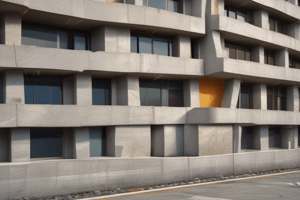Podcast
Questions and Answers
What type of finish has a great deal of texture and is very slip resistant?
What type of finish has a great deal of texture and is very slip resistant?
- Rough finish
- Honed finish
- Polished finish
- Thermal finish (correct)
What is a factor that an architect must consider when selecting a stone to be used in a building?
What is a factor that an architect must consider when selecting a stone to be used in a building?
- The color of the stone
- The grain of the stone (correct)
- The location of the stone
- The weight of the stone
What is the primary source of plastics?
What is the primary source of plastics?
- Wood
- Recycled materials
- Petroleum (correct)
- Coal
What is the characteristic of thermoplastics?
What is the characteristic of thermoplastics?
What is a common use of thermoplastics?
What is a common use of thermoplastics?
What is the advantage of thermoplastics over thermosetting plastics?
What is the advantage of thermoplastics over thermosetting plastics?
What is a characteristic of thermosetting plastics?
What is a characteristic of thermosetting plastics?
What is a common property of plastics?
What is a common property of plastics?
What is a common use of plastics?
What is a common use of plastics?
What is a characteristic of natural stones?
What is a characteristic of natural stones?
Flashcards are hidden until you start studying
Study Notes
Concrete
- Concrete is a mixture of cement, water, and aggregate, binding together to form a monolithic whole.
- Basic materials required for concrete: cement, fine aggregate (sand), coarse aggregate (gravel or crushed stone), and water.
- Admixtures may be added to modify the properties of the concrete.
- Ready-mixed concrete is typically used for commercial and residential projects, while concrete for large projects is mixed on-site.
- Mix design involves determining the correct amounts of ingredients to achieve the required durability, strength, and other properties.
- Proper curing is essential for obtaining good concrete, with a curing period ranging from 3 to 14 days.
- Curing involves subjecting the concrete to favorable temperature and moisture conditions.
Cement
- Cement is the essential component of concrete, binding the aggregate together to form a hard, strong, and monolithic whole.
- Cement is manufactured by heating a mixture of clay and limestone to form a clinker, which is then ground into a fine grey powder.
- Cement reacts with water to form a hard, strong bond.
- Cement must be kept dry to prevent it from setting or hardening prematurely.
Aggregates
- Coarse aggregate provides bulk to the concrete mix and contributes to the final strength of the concrete.
- Fine aggregates fill the space between coarse aggregate particles, making the concrete denser and less porous.
- Aggregates are used to reduce cost, as they are easily available and cheaper than cement.
Building Elements Manufactured from Concrete
- Building elements manufactured from concrete include foundations, columns, walls, slabs, roofs, blocks, and other small building units.
- Concrete is strong in compression but weak in tension, requiring reinforcement with steel bars for structural elements.
- Reinforced concrete has several advantages, including higher strength, durability, and good thermal and noise insulation properties.
Metal
- Metal is widely used in the construction industry for structural and non-structural components.
- Examples of metal uses include trusses, beams, light frame structures, panels, grilles, stair balustrades, and window frames.
Bricks
- Common bricks are not designed for good finished appearance, regularity of size, shape, and high strength.
- Facing bricks are manufactured to provide a good finished appearance, with a higher cost and better appearance than common bricks.
- Engineering bricks are designed for strength and durability, with a higher cost and exceptional hardness.
Glass
- The primary raw materials used in glass manufacture are silica, soda, and lime.
- There are various types of glass used in construction for different purposes.
Natural Stones
- Natural stones are resistant to degradation, but can be damaged by certain chemicals.
- Factors to consider when selecting natural stones for a building include cost, strength, durability, hardness, grain, color, texture, and porosity.
Plastics
- Plastics are a group of synthetic materials extracted from petroleum or coal.
- There are two main groups of plastics: thermoplastics and thermosetting plastics.
- Thermoplastics can be repeatedly softened by heat and hardened by cooling, allowing for recycling and reuse.
- Thermosetting plastics cannot be reheated and reformed once they have been softened.
- Plastics are used in various construction applications, including sanitary equipment, piping, floor coverings, and ornamental items.
Studying That Suits You
Use AI to generate personalized quizzes and flashcards to suit your learning preferences.




